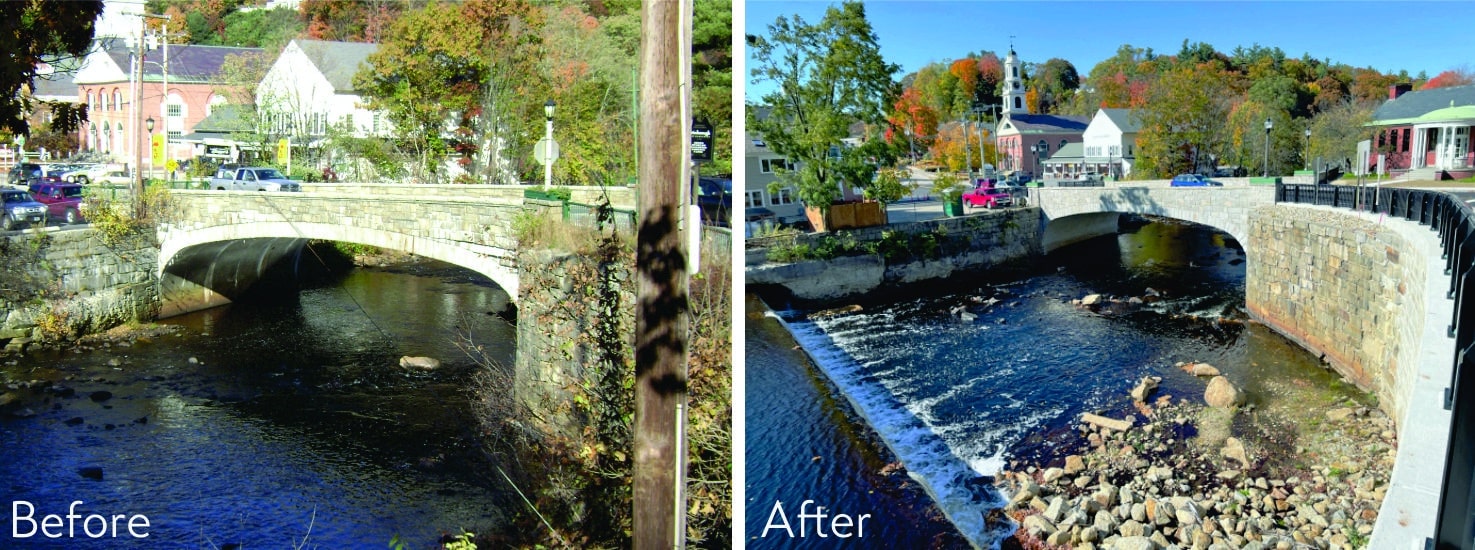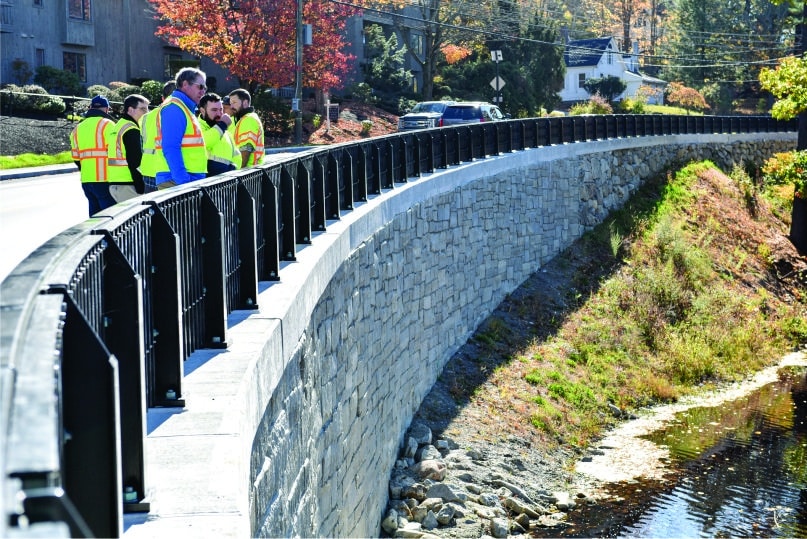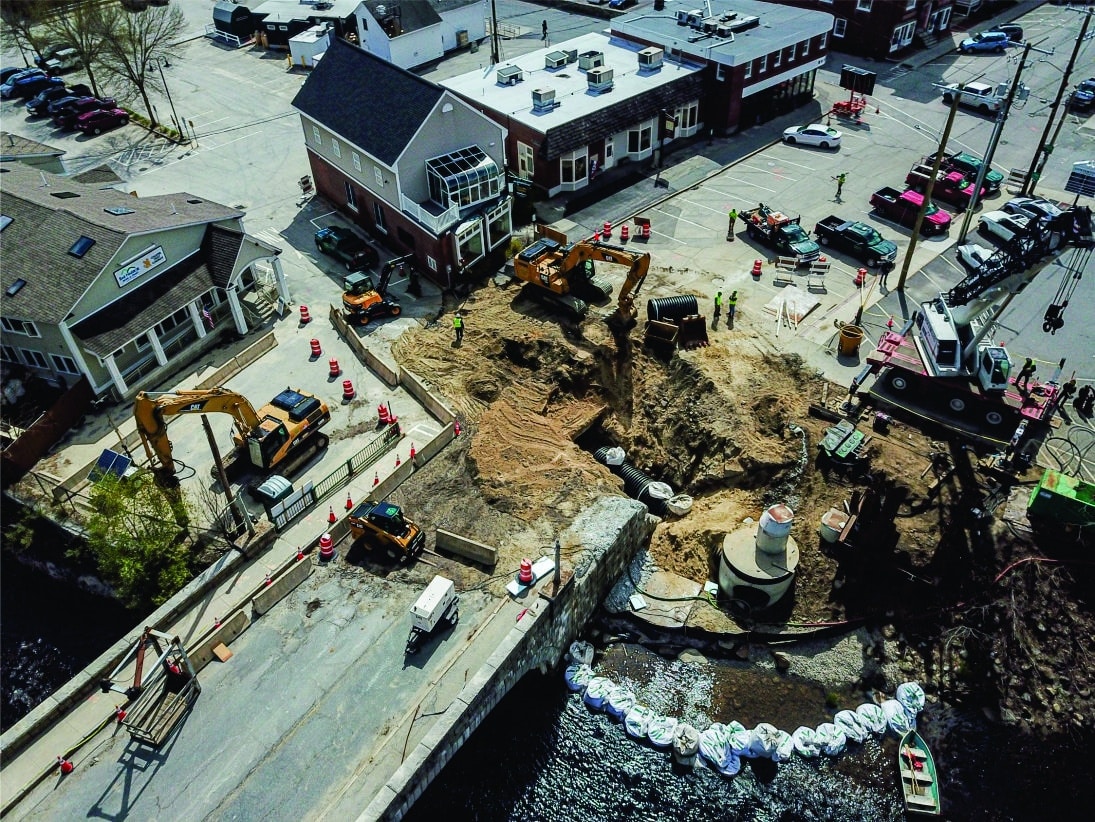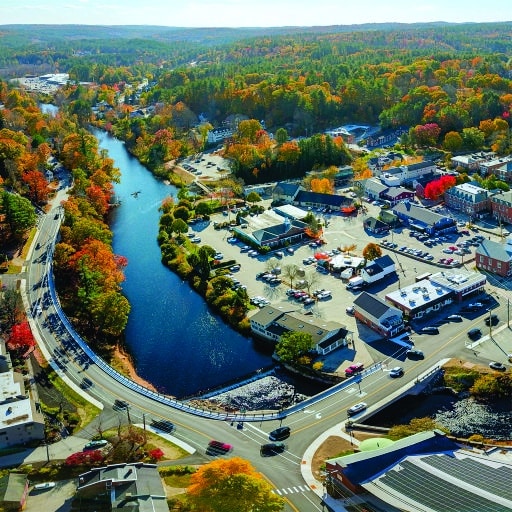Hoyle Tanner led the design and construction inspection for this signature project located on Main Street in downtown Peterborough. At $18 million, this multi-year, multi-discipline project is one of the largest and most complex to be completed through the Local Public Agency (LPA) program and includes the replacement of the historic Main Street Bridge over the Contoocook River with important safety improvements to US Route 202. This project is one of the largest projects to be administered through the LPA process to date. It showcases how a careful and detailed approach to design and construction can be used to create new and enduring infrastructure that can both pay tribute to lost historic elements and complement those that remain.

The replacement of the historic, but structurally deficient, Main Street Bridge over the Contoocook River in downtown Peterborough was the catalyst for this comprehensive project that also included:
- Realignment, widening, and reconstruction of approximately 850’ of US Route 202
- Construction of a new sidewalk along the eastern side of US Route 202
- Construction of a new stone-faced steel king pile and sheeting retaining wall
- In-situ stabilization of an historic boulder retaining wall
- Reconstruction of a portion of the Transcript Dam
- Lining of an historic granite canal
- Extensive utility coordination and relocation work
The Main Street Bridge is located in Peterborough’s Historic District, and both the bridge itself as well as the District were determined to be eligible for listing on the National Register of Historic Places due historic significance. Therefore, consideration of the historic and cultural impacts was critical to both the alternatives analysis and project development processes. Minimizing impacts to vehicular and pedestrian traffic, and by extension to downtown businesses, was also a key consideration. Balancing the desires of the Town (including the Peterborough Heritage Commission), New Hampshire Department of Transportation (NHDOT), New Hampshire State Historic Preservation Officer (NHSHPO) and Advisory Council on Historic Preservation (ACHP) was a collaborative and iterative process. One outcome of this coordination was to emulate the appearance of the existing bridge by reusing the existing stones on the replacement structure.
Public and stakeholder engagement continued throughout design and into construction in the form of regular update meetings with various federal, state and local agencies, as well as with the general public. Beginning in 2009, Hoyle Tanner either facilitated or participated with a significant role in over 50 public and/or agency meetings to gain support for, and consensus on, this complex project.
This project showcases numerous design innovations, including:
- King pile & steel sheeting retaining wall – The use of discrete steel king piles in conjunction with more conventional driven steel sheeting allows for a wall with a narrower footprint
 than a concrete cantilever spread footing wall. It also eliminates the need for tie-backs that would have potentially conflicted with the existing utilities in US Route 202 and would have been challenging to install from below.
than a concrete cantilever spread footing wall. It also eliminates the need for tie-backs that would have potentially conflicted with the existing utilities in US Route 202 and would have been challenging to install from below. - In-situ stabilization of the historic boulder retaining wall – The combination of grout injection and rock-socketed micropiles was used to stabilize and strengthen the existing boulder wall while preserving the appearance of the existing historic wall.
- “Preservation of Design” approach to the Main Street Bridge – Modern design and construction techniques were adapted into the reconstruction of the cast-in-place concrete rigid frame bridge which was designed to emulate the existing structure by matching its geometry and overall appearance. High-strength concrete was also used to construct the bridge parapets which were designed for modern vehicular impact loading while maintaining the stone facing, geometry, and overall appearance of the existing parapets that allowed for only a 6” thick reinforced concrete core.
- Sliplining of the existing stone masonry canal – Construction time and cost was reduced by leaving a portion of the existing granite canal in-place and installing a 60” diameter HDPE slipline pipe. This approach minimized excavation and reduced the need for temporary excavation support. It also allowed for salvaging the existing granite top slabs for future reuse.
- Leveraging technology to help satisfy environmental commitments – Documentation of the Main Street Bridge before, during, and after its deconstruction was stipulated in the Memorandum of Agreement between Peterborough, NHDOT, and Federal Highway Administration (FHWA), and much of the required documentation was gathered with either a high-resolution web-connected streaming camera (EarthCam) or via drone flights to capture aerial imagery.

The Peterborough Main Street Bridge and US Route 202 Intersection / Retaining Wall project is an excellent example of the successful completion of a complicated and multi-faceted municipally-managed project utilizing a combination of funding sources. Many stakeholders were instrumental in guiding the project toward a preferred alternative including Town officials, downtown business merchants, abutters, NHDOT, NHDHR, NHDES, NOAA, and FHWA. The investment in this project will pay dividends for generations to come by maintaining the downtown character of Peterborough yet also providing a safe, reliable, and world-class infrastructure asset.


*It’s Hoyle Tanner’s 50th anniversary this year! Keep an eye on our Facebook, LinkedIn, and Twitter feeds for articles and anniversary news!









